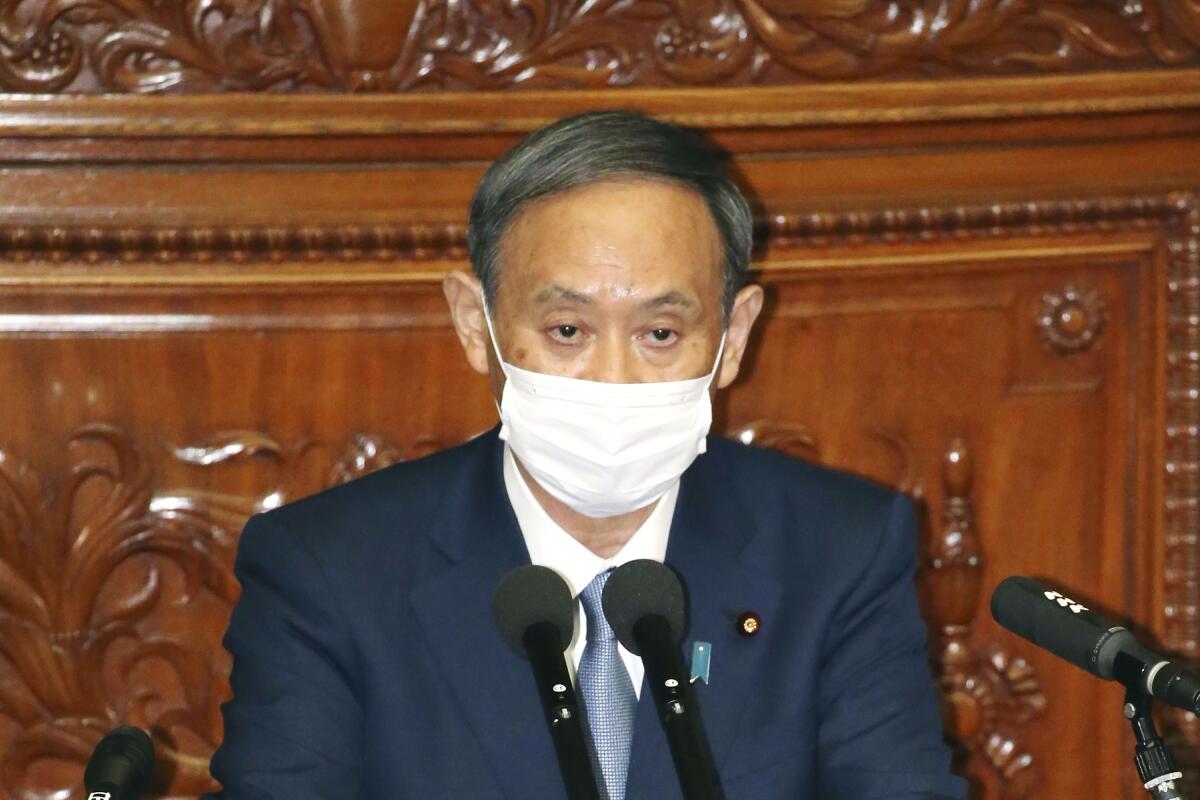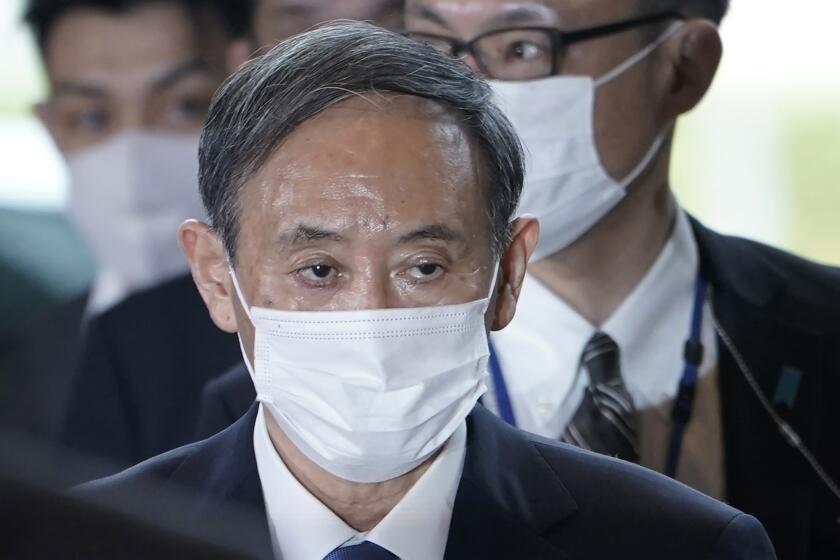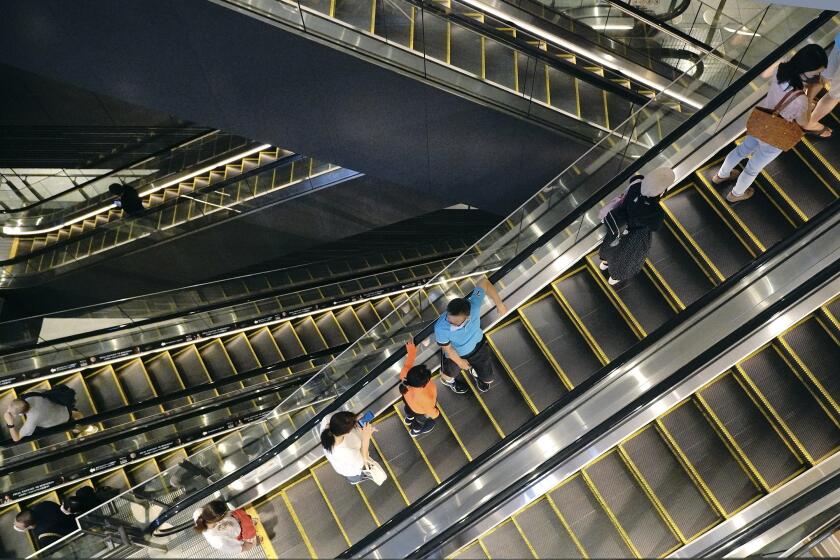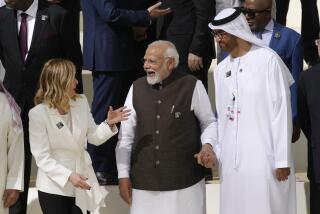Japan to go carbon-free by 2050, new leader Suga pledges

- Share via
TOKYO — Japan will achieve zero carbon emissions by 2050, Prime Minister Yoshihide Suga declared Monday in his first policy speech as leader, outlining an ambitious agenda as the country struggles to balance economic and COVID-19 pandemic concerns.
The policy speech at the outset of the parliamentary session reflects Suga’s pragmatic approach to getting things done. Suga, formerly chief Cabinet secretary, took office Sept. 16 after his boss, Shinzo Abe, resigned because of health problems.
Suga just returned from a trip last week to Vietnam and Indonesia, where he pushed ahead with Abe’s efforts to build closer ties and promote a regional vision for countering growing Chinese influence.
Now out of Abe’s shadow, back home Suga has been pumping out consumer-friendly policies. He has earned a reputation as a cost-cutter.
He said he intends to make a sustainable economy a pillar of his growth strategy and “put maximum effort into achieving a green society.” That includes creating a carbon-free society by 2050. Japan had previously targeted an 80% reduction in emissions by 2050.
The European Union and Britain have already set similar targets for net-zero greenhouse gas emissions by 2050, and China recently announced it would become carbon-free by 2060.
Before he got Japan’s top government job officially, Yoshihide Suga was known as a “shadow” prime minister and right-hand man to his long-serving predecessor.
Suga portrayed the need to shift away from fossil fuels to counter climate change as an opportunity rather than a burden.
“Global warming measures are no longer obstacles for economic growth, but would lead to industrial and socioeconomic reforms and a major growth,” he said. “We need to change our mind set.”
But it is unclear how resource-scarce Japan might attain the goal of weaning itself from polluting fossil fuels. The country’s current energy plan, set in 2018, calls for 22% to 24% of Japan’s energy to come from renewables, 20% to 22% from nuclear power and 56% from fossil fuels such as oil, coal and gas.
Progress toward reducing reliance on fossil fuels has been hindered by the prolonged closures of most of Japan’s nuclear plants after the meltdown of the Fukushima Daiichi plant during the 2011 earthquake and tsunami in the northeastern Tohoku region.
Japan’s economy shrank a record 28% in the April-to-June quarter — more than originally feared — because of the coronavirus.
Energy experts are now discussing revisions to Japan’s basic energy plan for 2030 and 2050. The 2050 emissions-free target would require drastic changes and likely prompt calls for more nuclear plant restarts.
About 40% of Japan’s carbon emissions come from power companies, and they must use more renewable sources of energy while stepping up development of technologies using hydrogen, ammonia and other carbon-free resources, experts say.
Suga said he would speed up research and development on key technologies such as next-generation solar batteries and carbon recycling. He also promised to “fundamentally change Japan’s long-term reliance on coal-fired energy” by promoting conservation and maximizing renewables, while maintaining nuclear energy.
In the immediate term, measures to curb the pandemic while reviving the economy are the top priority, Suga said.
Toward a more sustainable California
Get Boiling Point, our newsletter exploring climate change, energy and the environment, and become part of the conversation — and the solution.
You may occasionally receive promotional content from the Los Angeles Times.
Turning to Japan’s biggest long-term problem, a low birthrate and shrinking population, Suga reiterated a pledge to provide insurance coverage for infertility treatments. He also vowed to promote paternity leaves for working fathers to ease the burden of child-rearing and homemaking on working mothers. He also promised more for single-parent households, more than half of which are living in poverty.
Among other highlights, Suga said:
—The Japan-U.S. alliance, a cornerstone of Japanese diplomacy and security, is key to achieving a “Free and Open Indo-Pacific” regional economic and security framework to counter China’s sway.
—Japan is open to meeting with North Korean leader Kim Jong Un to resolve conflicts over abductions of Japanese citizens years ago and wartime compensation and to normalize diplomacy with Pyongyang.
—South Korea is “an extremely important neighbor,” but it should drop its demands for compensation over Korean wartime forced labor to restore “healthy” bilateral relations.
Suga is best known for his effectiveness in corralling powerful bureaucrats to force through Abe’s policies. But since taking office he has crafted a populist and pragmatic image, winning public support for his relatively modest background and low-profile, hardworking style.
He has ordered his Cabinet to step up implementation of several projects including his earlier efforts to lower cellphone rates and accelerate use of online government, business and medical services.
“I will break administrative divisions, vested interests and bad precedents to push for reforms,” Suga said.
More to Read
Sign up for Essential California
The most important California stories and recommendations in your inbox every morning.
You may occasionally receive promotional content from the Los Angeles Times.












